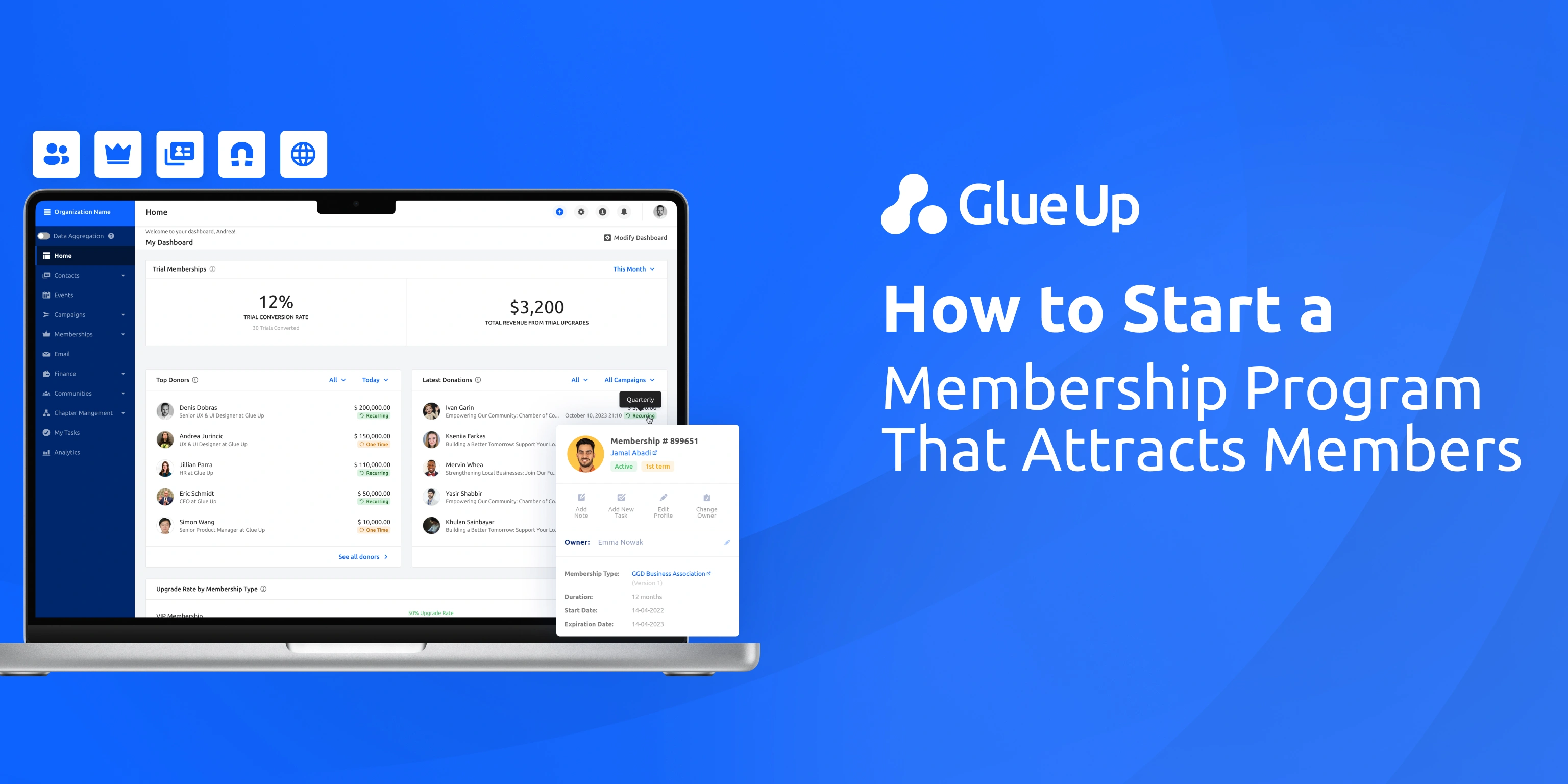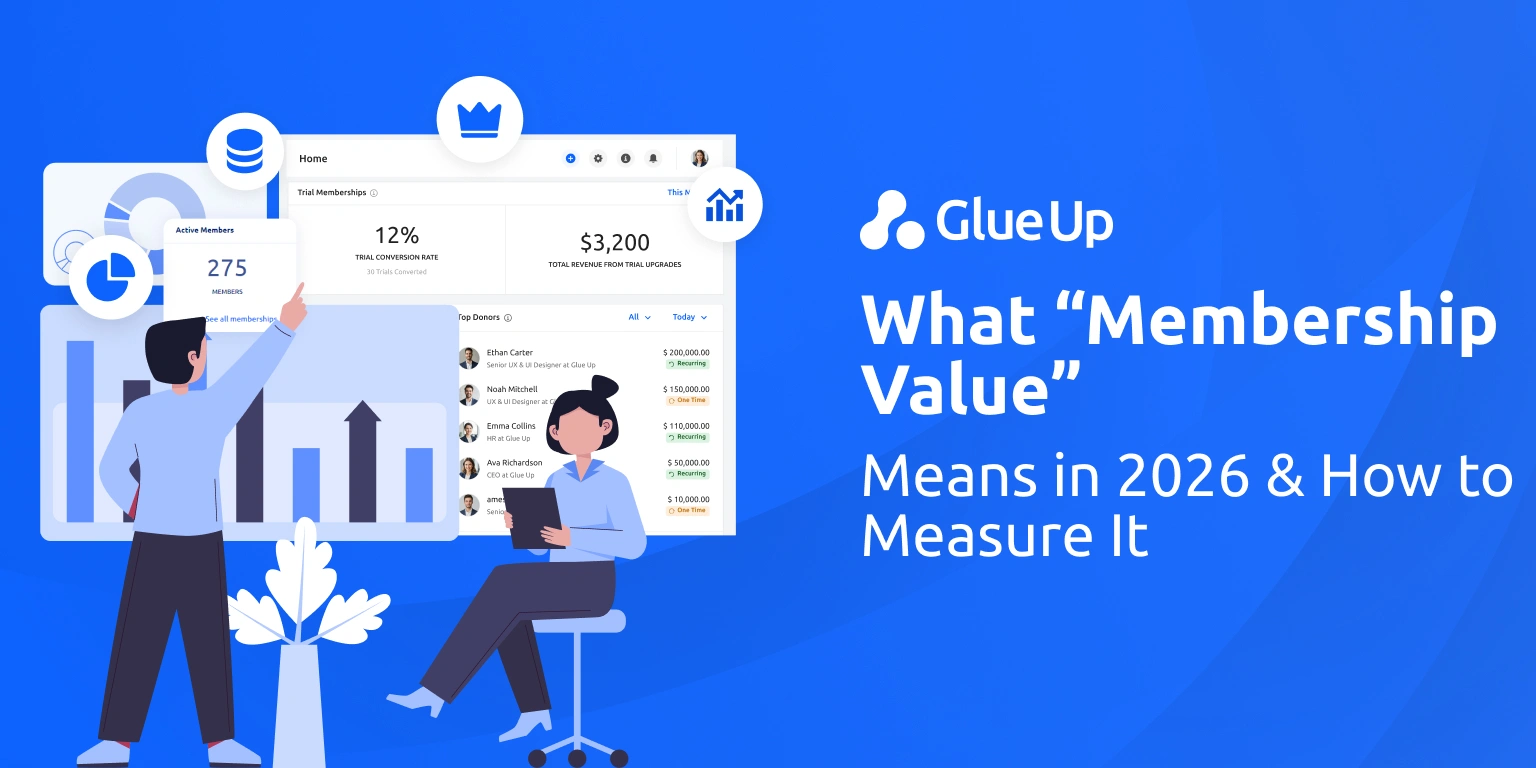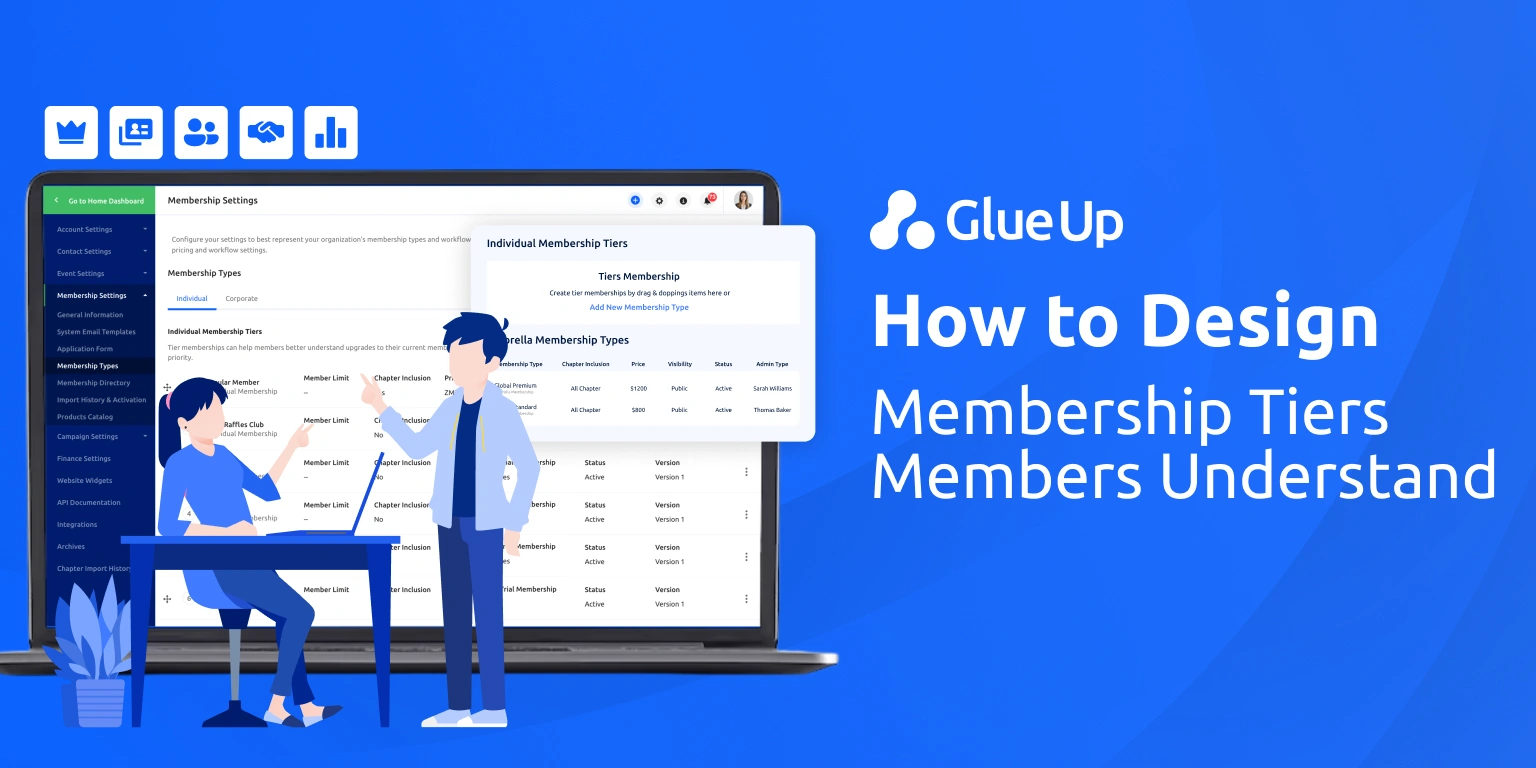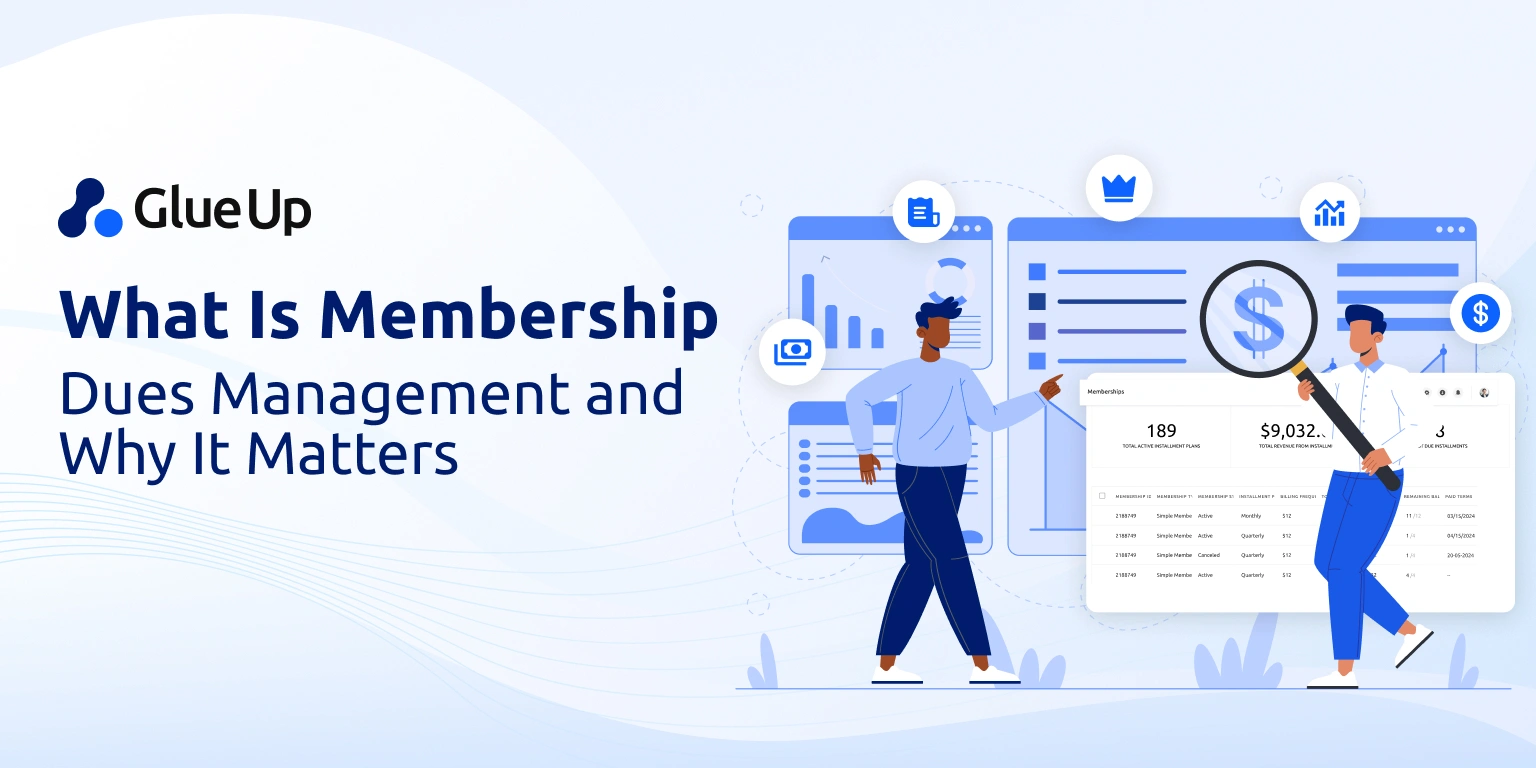
In 2024, 49% of associations reported membership growth—proof that demand for belonging and community-driven value is climbing steadily. With this momentum, the question of how to start a membership program is more relevant than ever for associations, chambers, and professional networks seeking sustainable revenue and stronger member loyalty.
A successful program doesn't just create another revenue stream. It establishes the framework for how members engage with your benefits, how they perceive your organization's value, and whether they commit for the long term.
In this post, we'll:
Explain why membership programs are growing in popularity and why now is the best time to launch one.
Walk through the key steps to design and structure your program, from membership tiers to onboarding experiences.
Share practical tips for marketing, retention, and renewals so your program stays relevant long term.
Highlight how Glue Up's all-in-one membership management software simplifies CRM, events, finance, and community building workflows.
If you already run a membership program and are looking for an all-in-one solution to simplify operations, Glue Up connects your CRM, events, campaigns, and finance in a single platform. Watch the video and book a quick demo to see how it can fit into your workflow.
Key Takeaways
Starting a membership program in 2025 means more than revenue — it's about creating loyal, long-term relationships with your community.
Clear membership tiers and well-defined benefits set the stage for stronger engagement and retention.
Smart promotion across channels works best when paired with automation and tools that keep members connected in one place.
Onboarding and renewal strategies can make or break your program's success, so build them intentionally.
With Glue Up's all-in-one membership management platform, you can streamline CRM, events, campaigns, and finance — freeing up time to focus on growth and member impact.
What is a Membership Program?
Think about the memberships you already know: a gym pass that gives you access to equipment and classes, or a streaming subscription that unlocks shows and movies. At their core, these are all memberships — structured exchanges of recurring payments for ongoing access and value.
Now, as an association leader, your version looks different. Instead of treadmills or TV shows, your members expect professional growth, advocacy, networking, and exclusive resources. And unlike a simple subscription, their decision to join your program reflects not just what they get, but the community they become part of.
"At its core, a membership program in your world is a structured system where individuals or businesses commit through dues or fees, and in return they receive ongoing access to events, resources, member-only content, and opportunities to build relationships. Done right, it moves beyond transactions to become the foundation for long-term loyalty and engagement."
Key Differences Between Membership & Other Revenue Models
Not all recurring revenue models are created equal. A membership program is not the same as a subscription, loyalty card, or donor base — and as an association leader, knowing these differences is critical.
Membership vs. Subscription: A subscription is transactional: pay monthly, get access, cancel anytime. Memberships, on the other hand, are relational. Your members expect engagement, recognition, and a sense of belonging that a subscription alone can't provide.
Membership vs. Loyalty Program: Loyalty programs reward repeat purchases. Membership programs reward commitment to a shared mission. Where loyalty is about points and discounts, membership is about shared values, professional development, and building an engaged community.
Membership vs. Donations: Donors give to support your cause, but they don't expect benefits in return. Members pay dues because they want both impact and access — advocacy, networking, events, or member-only content that directly benefits them.
Understanding these distinctions ensures you're not just "adding another revenue stream." You're building a model that shapes how people see your value, why they join, and how long they stay.
Why Membership Programs Are Growing in Popularity
If you're wondering what's driving all the buzz around membership models, here's what association leaders are seeing in action:
Since 2024, new member acquisition has gone up to 51%, a sign of ongoing demand and effective recruitment strategies.
Renewal remains a strength: median renewal rates hold steady at around 81%, while first-year renewals average about 63%.
Membership dues are the backbone of association finances, representing roughly 58% of total revenue.
But why are memberships resonating more than ever? Here's what's behind the trend:
Reliable non-dues revenue – Unlike ticket sales or sponsorships, memberships deliver predictable cash flow year over year.
Stronger member engagement – A recent study found that associations with engagement plans saw a 51% increase in membership renewals and 50% higher event attendance.
Compelling value propositions fuel growth – Associations that convey a clear sense of value grow faster. In fact, 58% report their value proposition as "compelling" or "very compelling", an increase from 51% in 2023.
Community and belonging matter – Members join not just for resources, but for connection, identity, and networking in an ongoing, purposeful community.
Another factor fueling this momentum is the rise of advanced membership management platforms like Glue Up, which centralize member data, automate renewals and payments, and give associations real-time insights to grow stronger programs.
Book a demo today to see how the right tech stack can help you build a membership program that's both sustainable and scalable.
Design Your Membership Structure
Once you've decided to launch, the next big step is how you design your membership structure. Get this wrong, and you risk confusing potential members or leaving money on the table. Get it right, and you create clarity, exclusivity, and scalable revenue streams that members see as a fair exchange for value.
Think of it like building a house. Your membership model is the blueprint, and your membership tiers are the rooms you furnish. Each tier should align with the type of member you want to attract, the benefits they expect, and your organization's revenue goals.
Membership Levels and Tiers
- Entry-Level Memberships – Perfect for students, early-career professionals, or small business owners who want access to basic resources at a lower cost.
Mid-Tier Memberships – Offer more extensive benefits such as networking opportunities, member-only content, or discounted event tickets.
Premium or Corporate Memberships – Tailored for organizations or seasoned professionals looking for sponsorship opportunities, leadership pathways, or expanded visibility in the business community.
Benefits for Organizations and Members
Your structure should deliver clear wins for both sides:
For Members – Access to exclusive resources, community, and professional growth.
For Your Organization – Predictable, recurring revenue streams and deeper member engagement.
Long-Term Thinking
Finally, don't design your program only for the launch. Consider how your tiers will evolve with member needs. Will you add new paid memberships, create member-only content, or develop exclusive networking perks in the future? A flexible structure allows your program to grow alongside your members' expectations.
Common Mistakes to Avoid When Structuring Tiers
Even if you've nailed down the idea of membership tiers, it's easy to fall into traps that hurt engagement and retention. Here are a few mistakes to watch out for:
Too Many Levels
It might be tempting to offer every possible tier—student, professional, silver, gold, platinum—but more isn't always better. Too many options overwhelm potential members and stall decision-making. Most successful associations stick to 3–4 clear levels that map to specific segments like students, individuals, and corporate members.
Unclear or Overlapping Benefits
Members should be able to immediately see what each tier offers and how it's different from the rest. If two levels look almost identical, members pick the cheapest one or opt out altogether. For example, what justifies the higher fee if both "Professional" and "Premium" levels include networking events and newsletters?
Underpricing Your Program
Many organizations undervalue their benefits out of fear of scaring members away. However, underpricing can actually hurt credibility and sustainability. A $20 annual membership might seem attractive, but if it doesn't cover program costs or align with perceived value, it won't retain members long term. Benchmarking against similar chambers or associations is a smart way to set realistic pricing.
Failing to Reassess Over Time
What worked five years ago may not work now. As your members' needs evolve—like demand for digital content, mobile access, or professional certifications—your tiers need to evolve too. Neglecting regular reviews risks making your program feel outdated.
Decide on Member Benefits
Once you've mapped out your membership levels, the next big step is deciding what benefits members will actually receive. Benefits are the core of your value proposition—they're why someone joins, renews, and advocates for your organization.
When you're designing benefits for a successful membership program, keep these best practices in mind:
Balance Tangible and Intangible Value
Discounts on events and access to member-only content are valuable, as is the sense of belonging and professional identity. For instance, local chambers often provide networking breakfasts and policy updates that deepen members' sense of community.
Tailor Benefits to Each Tier
Not all members need the same things. An entrepreneur might value exposure through your business directory, while a corporate member may prioritize advocacy and government relations. Aligning benefits with tiers prevents one-size-fits-all packages that dilute perceived value.
Highlight Exclusive Access
People join memberships for access they cannot get elsewhere. Whether it's private online forums, leadership training, or members-only research reports, exclusivity creates loyalty and justifies pricing.
Evolve Benefits Over Time
Members' needs shift. What worked a few years ago—like physical newsletters—might feel outdated. Regularly review engagement data to add modern perks such as mobile event check-ins, webinars, or online resource libraries.
Common Mistakes to Avoid
- Overloading Benefits: Trying to please everyone often overwhelms members with perks they don't use. Instead, prioritize high-value offerings that align with your mission.
Vague Promises: Benefits like "networking opportunities" are too broad. Spell out what that means—monthly mixers, quarterly roundtables, or a digital member portal.
Ignoring ROI: If your benefits cost more to deliver than what you charge, your program will quickly lose sustainability.
Choose the Right Technology Platform
Even the strongest membership structure and most compelling benefits will fall short if you don't have the right tools to support them. As an association leader, you juggle CRM, events, renewals, campaigns, and finance. A membership program adds complexity that only a robust technology platform can simplify.
Here's what to look for when evaluating your options:
Functionality
Running membership management, events, and communication in separate tools creates silos and double work. Ideally, you should opt for an all-in-one platform to connects these workflows and manage member profiles, payments, and campaigns in one place.
Automation for Renewals & Communication
Manual reminders are a drain on your staff and often lead to missed deadlines. Automated renewal notifications, segmented email campaigns, and payment processing keep your revenue steady without overwhelming your team.
Member Portals & Self-Service Options
Your members expect the same convenience they get from consumer apps. A secure portal where they can update details, pay dues, and access member-only content creates a modern experience that builds satisfaction and loyalty.
Event Integration
Events are a core driver of engagement, so your platform should connect event registration, ticketing, and check-in directly with your membership data. That way, every interaction strengthens your relationship with members.
Analytics & Reporting
Knowing what's working is half the battle. Look for dashboards that track retention, event participation, and revenue, so you can refine your strategy and prove value to your board.
Glue Up brings all these must-have features—and more—into one powerful, easy-to-use platform. Book a quick demo to see it in action for your organization.
Develop a Marketing & Recruitment Plan
Even the best-designed membership program won't thrive if potential members don't know it exists. A strong marketing and recruitment strategy ensures your message reaches the right audience and turns interest into sign-ups.
Start with Clear Messaging
Your value proposition should answer one question: Why should I join? Highlight benefits like networking, professional development, or exclusive member-only content, and tailor messaging to different membership tiers.
Use Multi-Channel Promotion
Don't rely on one platform. To build awareness, combine email campaigns, social media, your membership website, and in-person events. Associations that diversify channels report stronger membership growth than those relying solely on email.
Pro Tip: Instead of scattering your members across different platforms, funnel them into one space using community management software, where discussions, updates, and engagement happen in one hub.
Leverage Testimonials and Case Studies
Peer influence matters. Showcase stories from satisfied members to make your benefits more relatable and authentic.
Pro Tip: Ask members to share video testimonials or quotes on LinkedIn and tag your chamber or association page to boost reach organically.
Run Time-Bound Campaigns
Urgency drives action. Consider early-bird discounts, limited-time bonuses, or special access to boost sign-ups.
Pro Tip: Pair time-limited offers with automated, behavior-based reminders—for example, targeting those who visited your membership page but didn't sign up with a personalized nudge.
Track Results and Adjust
Monitor conversion rates, campaign ROI, and channel performance. Use those insights to refine your strategy each year.
Common Mistakes to Avoid
- Promoting Without Segmentation: Sending the same message to everyone leads to low engagement. You can use Glue Up Smart Lists to group members and prospects by interests, career stage, or engagement level to personalize outreach.
Neglecting Your Existing Members: Recruitment is important, but retention campaigns often deliver higher ROI.
Build a Memorable Onboarding Experience
Getting new members to sign up is often the easy part. The bigger challenge is keeping them engaged and turning sign-ups into loyal advocates. A structured onboarding process ensures members don't just join your program, but experience the value you've promised.
Here's what your onboarding should include:
Welcome Communications: Automated welcome emails or a personalized message from leadership to make members feel valued immediately.
Orientation Resources: Access to a "Getting Started" guide, explainer videos, or FAQs that help them understand benefits and how to use them.
First Engagement Opportunities: Invitations to introductory webinars, networking meetups, or community spaces designed specifically for new members.
Tier-Specific Journeys: Onboarding is tailored to membership levels (e.g., basic members receive access to community forums, and premium members get assigned a mentor).
Pro Tip: Use Glue Up's email automation software to drip-feed onboarding over the first 30–60 days. For example, you might send a welcome email in week one, a "how to maximize your benefits" video in week two, and an invitation to a networking event in week three. That pacing prevents overwhelm while steadily building engagement.
Manage Renewals & Retention
Even the best-designed membership program won't thrive without consistent renewals. Retention is where long-term sustainability is won or lost. While acquiring new members is important, studies show it can cost 5–7 times more to gain a new member than to retain an existing one — making renewals a critical part of your strategy.
How to strengthen renewals and retention:
Automated Reminders: Send timely renewal notices through email, SMS, or push notifications so members never miss deadlines.
Member Value Updates: Regularly remind members of the benefits they've received (e.g., event discounts, exclusive resources, or networking opportunities).
Tier-Specific Incentives: Offer small perks like early access to events or bonus resources for renewing at higher tiers.
Behavioral Insights: Use engagement data (e.g., event attendance, content downloads, or community activity) to segment at-risk members and send personalized outreach.
Pro Tip: Instead of waiting until the renewal date, start nurturing renewals at least 90 days out. Highlight "member wins" or ROI stories in newsletters, and frame renewal as the next step in their journey, not just another bill.
Don't Stop At How to Start a Membership Program
Launching a membership program isn't just about setting up tiers and collecting dues. It's about building a framework where members feel your value, engage consistently, and stick around for the long haul. When you combine smart strategy with the right technology, your program can become a reliable growth engine for your organization.
If you're ready to simplify operations and scale faster, Glue Up's all-in-one membership management platform brings CRM, finance, events, and campaigns together in one place. With automation, community tools, and built-in analytics, you'll spend less time juggling software and more time creating impact.
Book a quick demo to see how Glue Up can power the membership experience your members deserve.



